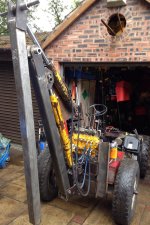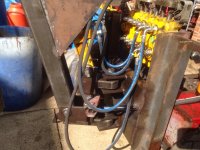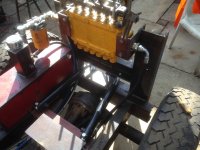OK, I've managed to connect up the hydraulics now using a temporary reservoir tank that I made from a steel box that was lying around. It's a bit on the small side but fits nicely in the space and can be replaced with a larger custom made thing at a later date.
Here's a description of how I have plumbed the hydraulic circuit:
1P3060 hydraulic pump, around 27lt/min @ 1500rpm
Pumps directly to a Danfoss A80 priority valve on the orbital steering valve.
Output of steering valve goes to an old marine double ended steering ram that I adapted and fixed to the Land Rover front axle.
The priority valve ensures I will always have flow and pressure to steer regardless of other demands on the system.
Main hydraulic flow is taken from priority valve outlet and piped up to a 1/2" - 6 bank spool valve mounted at the front of the digger.
This valve is a bit of an overkill here but has a power beyond (carry over) feature which shares the hydraulic flow with the huge ex-Massey Ferguson backhoe valve that is now fixed in place at the rear.
I'm using one of the front spool valve functions to drive the main transmission 160 hydraulic motor which works well except that in neutral it locks off the motor completely rather than allowing free-wheeling. I will have to change out this spool at some point as it is too jerky and something will break. The other five spools will be used for the Front End Loader that I haven't even though about yet.
At the rear the massive backhoe valve fitted in nicely and is now fully operational.
The flow from this valve returns to the tank via a tee piece to a filter unit currently mounted above the reservoir.
The return from the front spool valve also feeds back to the filter via this tee.
Here's a photo of the backhoe and valve.

The main boom is now 100 x 100 x 6mm RHS, I'm using the lighter 90 x 90 x 5mm RHS as the stick but will be plating both sides with 5mm thick steel plates now I have a plasma cutter.

The boom top ram mount has two positions and at its lowest point will allow deeper digging, not sure if this was a good idea or not but it's all welded up now so it's staying...
The rest of what you see here is a mock up just tack welded together to figure out stuff. I've already changed it since I took the photo but it was too dark when I finished to take another.
The 2" stick ram has since been changed out, it leaked and was too heavy and too short a stroke. The stick pivot and lengths have also been changed.
I'm working on the slew rams and brackets now....


